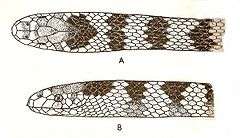Hydrophis cyanocinctus
Hydrophis cyanocinctus, commonly called the annulated sea snake or the blue-banded sea snake, is a species of venomous sea snake in the family Elapidae.[2]
| Hydrophis cyanocinctus | |
|---|---|
 | |
| Scientific classification | |
| Kingdom: | Animalia |
| Phylum: | Chordata |
| Class: | Reptilia |
| Order: | Squamata |
| Suborder: | Serpentes |
| Family: | Elapidae |
| Genus: | Hydrophis |
| Species: | H. cyanocinctus |
| Binomial name | |
| Hydrophis cyanocinctus Daudin, 1803 | |
| Synonyms | |
Description
Head moderate. Diameter of eye less than its distance from the mouth in the adult. Rostral slightly more broad than deep. Nasals shorter than the frontal, more than twice as long as the suture between the prefrontals. Prefrontals usually in contact with the second upper labial. Frontal more long than broad, as long as its distance from the rostral or the tip of the snout. One preocular and two postoculars. Two superposed anterior temporals. Seven or eight upper labials; third, fourth, and usually fifth entering the eye. Both pairs of chin-shields in contact, or posterior pair separated by one scale.
Body long. Dorsal scales subimbricate, keeled or with two or three tubercles, in 39-45 rows (27-33 anteriorly). Ventrals 281-385, smooth or with two or more tubercles.
Greenish-olive above, with blackish or olive transverse bars or annuli, broadest on the back, sometimes connected by a black band along the belly; or yellowish, with a black vertebral band and a few black bars on the neck.
Length of head and body 1360 mm; tail 140 mm.[3]
In a 2019 study it has been found it uses a complex system of blood vessels in its head called, the Modified Cephalic Vascular Network (MCVN) which is an adaptation that helps provide the brain with extra oxygen when submerged.[4]
Distribution
Found in the Indian Ocean (From the Persian Gulf, Iran, Pakistan, India, Sri Lanka, Bangladesh, Myanmar, Thailand, Malaysia, Philippines: Visayan Sea, Panay, etc.) and the marine waters around Korea, Japan, Solomon Islands, South China Sea (including Hainan), East China Sea (including Taiwan), coastal regions of Shandong and Liaoning (China) coasts of Persian Gulf (Oman, United Arab Emirates), east through South Asia until New Guinea.

Behavior
Hydrophis cyanocinctus inhabits shallow coastal waters. It is often accidentally caught by prawn trawlers.[5]
Diet
It feeds on marine invertebrates and also on various groups of fish such as eels and gobies.[6]
Reproduction
This species is ovoviviparous. The young are born alive in broods of 3-16. The newborns are about 38 centimetres (15 in) long.[6]
References
- The Reptile Database. www.reptile-database.org.
- "Hydrophis". Integrated Taxonomic Information System. Retrieved 7 September 2007.
- Rooij, Nelly de. 1915. The reptiles of the Indo-Australian archipelago. Leiden.
- Palci, Alessandro; Seymour, Roger S.; Van Nguyen, Cao; Hutchinson, Mark N.; Lee, Michael S. Y.; Sanders, Kate L. (2019). "Novel vascular plexus in the head of a sea snake (Elapidae, Hydrophiinae) revealed by high-resolution computed tomography and histology". Royal Society Open Science. 6 (9): 191099. doi:10.1098/rsos.191099.
- Das, Indraneil. 2006. A Photographic Guide to Snakes and Other Reptiles of Borneo. Ralph Curtis Publishing. Sanibel Island. Florida. p. 67.
- Das, 2006.
Further reading
- Bussarawitt, S.; Rasmussen, A.R.; & Andersen, M. 1989. A preliminary study on sea snakes (Hydrophiidae) from Phuket Harbor, Phuket Island, Thailand. Nat. Hist. Bull. Siam Soc., Bangkok 37 (2): 209-225.
- Daudin, F.M. 1803. Histoire Naturelle, Générale et Particulière des Reptiles, Volume VII. Dufart. Paris. p. 383.
- Murray, J.A. 1887. Three New Species of Hydrophis. J. Bombay Nat. Hist. Soc. 2: 32-35.
